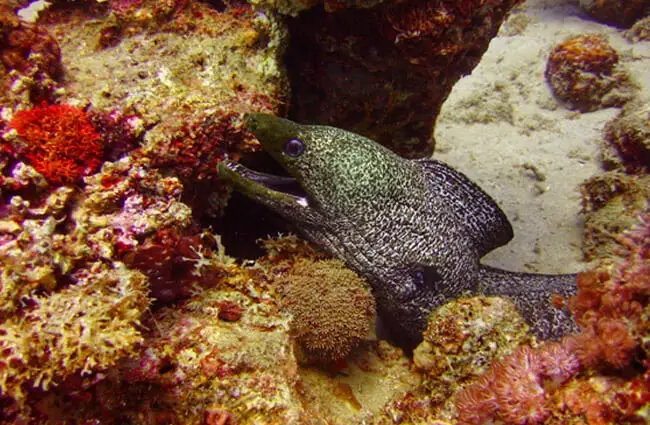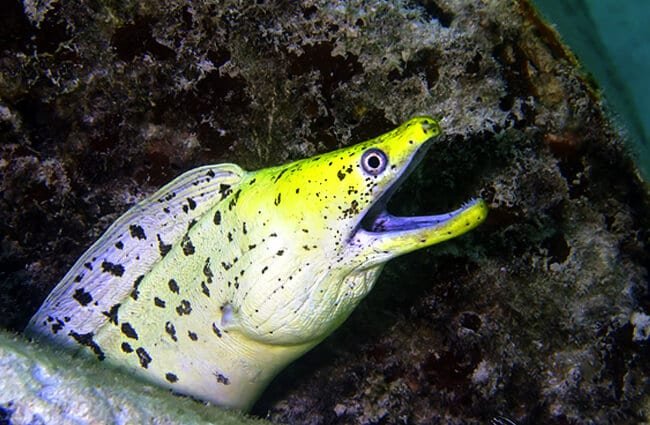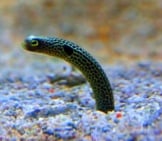A Conger, or Conger Eel, is any member of the taxonomic genus Conger. The group contains the largest species of eel, the European Conger.
Researchers recognize 14 different species in the family. Various species live in the waters around North America, Europe, Africa, Asia, and more. Read on to learn about the Conger.
Description of the Conger
Each species looks slightly different from the next. All have typical eel-shaped bodies that taper at the tail and have a fused dorsal and tail fin. Their rostrum, or snout, also comes to something of a point. Coloration varies, but most have grey, white, or brown colored skin.
Most species measure about 3 or 4 ft. long, but some reach nearly 20 ft. in length! Additionally, most individuals weigh between 5 and 50 lbs. but the heaviest reach 200 lbs. or more.
Interesting Facts About the Conger
These eels have numerous traits and adaptations to help them survive. Learn more about a few specific species, below.
- European Conger – Let’s start with the largest of the 14 species, and one the largest of all eels. This creature reportedly reaches a maximum of 19 ft. 8 in. long! They also reach up to 240 lbs., making them the heaviest eel species.
- American Conger – People refer to this species by several different names, including sea eel, poison eel, dog eel, and more. You can find them in the western Atlantic Ocean. People eat this species, primarily as a smoked fish.
- Whitespotted Conger – This species lives in the oceans around Japan and the surrounding regions. The Japanese consume this species commonly, and meat from this fish is known as anago.
Habitat of the Conger
The different species utilize different types of habitats. They typically prefer saltwater habitats. Some live in specific habitats or prefer certain substrates, while others live in a wide variety of habitat types. For the most part, they are benthic, or bottom-dwelling. Many prefer living of burrowing down into sand, mud, or rock.
Distribution of the Conger
Each species has its own unique range and distribution. Some live across vast ranges while others live in more isolated areas. They range through the oceans adjacent to Europe, Africa, North America, Asia, and more. The populations of some species overlap with those of other species.
Diet of the Conger
All of the various species are carnivorous, which means that they eat other animals. Their diet varies based on their size, species, and where they live. The larval young feed on random bits of edible material that drift through the water. As they grow larger, they eat zooplankton and other small organisms.
Adults primarily hunt fish, crabs, shrimp, worms, squid, and other aquatic prey. They also feed on carrion, or dead animals, when the occasion presents itself.
Conger and Human Interaction
Human interaction varies from species to species. Exceptionally large individuals, such as the European species, actually pose a danger to humans. Though they can pose a threat to people, very few recorded incidents exist of these eels attacking humans.
However, human activity also poses a danger to these aquatic creatures. Though most have stable populations, they face threat from habitat loss and climate change. Climate change in particular can impact their ability to reproduce, as the larval stage is sensitive to temperature, salinity, and acidity.
Domestication
Humans have not domesticated this fish in any way.
Does the Conger Make a Good Pet
No, you do not want to keep any of these eel species as pets. Even averaged-sized species reach lengths that would be difficult to care for in a home aquarium.
Conger Care
Some zoos and aquariums keep these fish for educational or breeding purposes. The size of their tank varies based on the species and age of the individual. Basically, the larger the eel, the larger the tank! For most species, feeding time is quite simple. They eat a variety of different fish, crabs, shrimp, squid, and more.
Behavior of the Conger
Each species has its own behavioral patterns. Most spend their days within rocky crevices or similar hiding places, and hunt at night. Their social behavior also varies. Some live in schools, and even share their hiding places with other eel species. Others live solitary lives and only congregate to spawn.
Reproduction of the Conger
All of the various species reproduce via spawning. This is when the females release their eggs, and the males release their sperm to fertilize the eggs. The eggs hatch into larvae known as “leptocephali.”
The tiny larvae undergo several stages of metamorphosis before they reach their adult form. The amount of time it takes to reach sexual maturity varies by individual and species.













![Red Angus Closeup of a beautiful Red Angus cowPhoto by: U.S. Department of Agriculture [pubic domain]https://creativecommons.org/licenses/by/2.0/](https://animals.net/wp-content/uploads/2020/03/Red-Angus-4-238x178.jpg)












![Red Angus Closeup of a beautiful Red Angus cowPhoto by: U.S. Department of Agriculture [pubic domain]https://creativecommons.org/licenses/by/2.0/](https://animals.net/wp-content/uploads/2020/03/Red-Angus-4-100x75.jpg)

